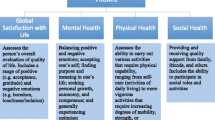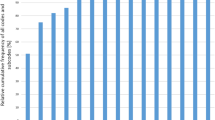Abstract
Purpose
The aim of this randomized controlled trial (RCT) was to test the effectiveness of a post-ICU recovery program compared to standard care during the first year after ICU discharge.
Methods
A pragmatic, non-blinded, multicenter, parallel-group RCT was conducted between December 2012 and December 2015, at ten intensive care units (ICUs) in Denmark. We randomly assigned 386 adult patients (≥18 years) after receiving mechanical ventilation (≥48 h) to standard care (SC) plus a nurse-led intensive care recovery program or standard care alone after ICU discharge (190 intervention, 196 SC). Primary outcome was health-related quality of life (HRQOL) at 12 months. Secondary outcomes were sense of coherence (SOC), anxiety, depression, and post-traumatic stress disorder (PTSD) assessed at 3 and 12 months after ICU discharge including utilization of healthcare services at 12 months.
Results
At 12 months, we found no differences in HRQOL between groups (mean difference in the Physical Component Summary score, 1.41 [95 % CI, −1.53 to 4.35; p = 0.35] (n = 235); and in the Mental Component Summary score, 1.92 [95 % CI, −1.06 to 4.90; p = 0.11] (n = 235). No differences were found on self-reported SOC (p = 0.63), anxiety (p = 0.68), depression (p = 0.67), PTSD (p = 0.27), or the utilization of healthcare services including rehabilitation. We found a difference on anxiety, when a cut-off point ≥11 was applied, in per protocol analysis of complete cases at 3 months favoring the intervention (8.8 % vs. 16.2 %, p = 0.04).
Conclusions
The tested recovery program was not superior to standard care during the first 12 months post-ICU.
Trial registration
The trial is registered at Clinicaltrials.gov, identification no. NCT01721239.



Similar content being viewed by others
References
Angus DC, Carlet J, Brussels Roundtable P (2003) Surviving intensive care: a report from the 2002 Brussels Roundtable. Intensive Care Med 29:368–377
Cuthbertson BH, Rattray J, Campbell MK, Gager M, Roughton S, Smith A, Hull A, Breeman S, Norrie J, Jenkinson D, Hernandez R, Johnston M, Wilson E, Waldmann C (2009) The PRaCTICaL study of nurse led, intensive care follow-up programmes for improving long term outcomes from critical illness: a pragmatic randomised controlled trial. BMJ 339:b3723
Griffiths JA, Barber VS, Cuthbertson BH, Young JD (2006) A national survey of intensive care follow-up clinics. Anaesthesia 61:950–955
NICE (2009) Rehabilitation after critical illness NICE clinical guidelines, no. 83. National Institute for Health and Clinical Excellence (UK), London
Jensen JF, Thomsen T, Overgaard D, Bestle MH, Christensen D, Egerod I (2015) Impact of follow-up consultations for ICU survivors on post-ICU syndrome: a systematic review and meta-analysis. Intensive Care Med 41:763–775
Egerod I, Christensen D, Schwartz-Nielsen KH, Agard AS (2011) Constructing the illness narrative: a grounded theory exploring patients’ and relatives’ use of intensive care diaries. Crit Care Med 39:1922–1928
Egerod I, Risom SS, Thomsen T, Storli SL, Eskerud RS, Holme AN, Samuelson KA (2013) ICU-recovery in Scandinavia: a comparative study of intensive care follow-up in Denmark, Norway and Sweden. Intensive Crit Care Nurs 29:103–111
Williams TA, Leslie GD (2008) Beyond the walls: a review of ICU clinics and their impact on patient outcomes after leaving hospital. Aust Crit Care 21:6–17
Ministry of Social Affairs (2009) Guidelines on training in municipalities and regions. [Vejledning om træning i kommuner og regioner]. Ministeriet for Sundhed og Forebyggelse: Indenrigs- og Socialministeriet, 2009
Jensen JF, Overgaard D, Bestle M, Christensen D, I E (2012) Recovery and Aftercare in Post Intensive care Therapy patients—The RAPIT study. The effectiveness and experiences of a follow-up program for Danish mechanically ventilated ICU patients: a pragmatic randomized controlled multicentre trial. www.clinicaltrials.gov, ID no. NCT01721239
Antonovsky A (1987) Unraveling the mystery of health: how people manage stress and stay well. Jossey-Bass, San Francisco, p 1–231
Frank AW (2013) The wounded storyteller: body, illness, and ethics. The University of Chicago Press, Chicago, pp 53–137
Zoffmann V, Kirkevold M (2012) Realizing empowerment in difficult diabetes care: a guided self-determination intervention. Qual Health Res 22:103–118
Bisson J, Andrew M (2007) Psychological treatment of post-traumatic stress disorder (PTSD). Cochrane Database Syst Rev: CD003388
Rutherford C, Costa D, Mercieca-Bebber R, Rice H, Gabb L, King M (2015) Mode of administration does not cause bias in patient-reported outcome results: a meta-analysis. Qual Life Res 25:559–574
Chrispin PS, Scotton H, Rogers J, Lloyd D, Ridley SA (1997) Short form 36 in the intensive care unit: assessment of acceptability, reliability and validity of the questionnaire. Anaesthesia 52:15–23
Eriksson M, Lindstrom B (2005) Validity of Antonovsky’s sense of coherence scale: a systematic review. J Epidemiol Community Health 59:460–466
Bjelland I, Dahl AA, Haug TT, Neckelmann D (2002) The validity of the hospital anxiety and depression scale. An updated literature review. J Psychosom Res 52:69–77
Association AP (2007) Diagnostic and statistical manual of mental disorders: DSM-IV-TRtm: text revision. American Psychiatric Association, Washington
Ratzer M, Brink O, Knudsen L, Elklit A (2014) Posttraumatic stress in intensive care unit survivors—a prospective study. Health Psychol Behav Med 2:882–898
Backman CG, Orwelius L, Sjoberg F, Fredrikson M, Walther SM (2010) Long-term effect of the ICU-diary concept on quality of life after critical illness. Acta Anaesthesiol Scand 54:736–743
Wood AM, White IR, Royston P (2008) How should variable selection be performed with multiply imputed data? Stat Med 27:3227–3246
Pocock SJ, Assmann SE, Enos LE, Kasten LE (2002) Subgroup analysis, covariate adjustment and baseline comparisons in clinical trial reporting: current practice and problems. Stat Med 21:2917–2930
Denehy L, Skinner EH, Edbrooke L, Haines K, Warrillow S, Hawthorne G, Gough K, Hoorn SV, Morris ME, Berney S (2013) Exercise rehabilitation for patients with critical illness: a randomized controlled trial with 12 months of follow-up. Crit Care 17:R156
Elliott D, McKinley S, Alison J, Aitken LM, King M, Leslie GD, Kenny P, Taylor P, Foley R, Burmeister E (2011) Health-related quality of life and physical recovery after a critical illness: a multi-centre randomised controlled trial of a home-based physical rehabilitation program. Crit Care 15:R142
Walsh TS, Salisbury LG, Merriweather JL, Boyd JA, Griffith DM, Huby G, Kean S, Mackenzie SJ, Krishan A, Lewis SC, Murray GD, Forbes JF, Smith J, Rattray JE, Hull AM, Ramsay P, RECOVER Investigators (2015) Increased hospital-based physical rehabilitation and information provision after intensive care unit discharge: the RECOVER randomized clinical trial. JAMA Intern Med 175:901–910
Bjorner JB, Damsgaard MT, Watt T, Bech P, Rasmussen NK, Kristensen TS, Modvig J, Thunedborg K (1997) Dansk manual til SF-36. Et spõrgeskema om helbredsstatus. Lif Lëgemiddelindustriforeningen, Kõbenhavn, pp 69–89
Due EP, Holstein BE (1998) “Sense of coherence”, social class and health in a Danish population study. Ugeskr Laeger 160:7424–7429
Fok SK, Chair SY, Lopez V (2005) Sense of coherence, coping and quality of life following a critical illness. J Adv Nurs 49:173–181
Bergman E, Arestedt K, Fridlund B, Karlsson JE, Malm D (2012) The impact of comprehensibility and sense of coherence in the recovery of patients with myocardial infarction: a long-term follow-up study. Eur J Cardiovasc Nurs 11:276–283
Arvidsdotter T, Marklund B, Taft C, Kylen S (2015) Quality of life, sense of coherence and experiences with three different treatments in patients with psychological distress in primary care: a mixed-methods study. BMC Complement Altern Med 15:132
Knowles RE, Tarrier N (2009) Evaluation of the effect of prospective patient diaries on emotional well-being in intensive care unit survivors: a randomized controlled trial. Crit Care Med 37:184–191
Jones C, Backman C, Capuzzo M, Egerod I, Flaatten H, Granja C, Rylander C, Griffiths RD (2010) Intensive care diaries reduce new onset post traumatic stress disorder following critical illness: a randomised, controlled trial. Crit Care 14:R168
Davydow DS, Gifford JM, Desai SV, Needham DM, Bienvenu OJ (2008) Posttraumatic stress disorder in general intensive care unit survivors: a systematic review. Gen Hosp Psychiatry 30:421–434
Regions of Denmark (2014) The national survey of patient experience [LUP Den Landsdækkende Undersøgelse af Patientoplevelser]. Danske regioner, Copenhagen, pp 1–83
Peris A, Bonizzoli M, Iozzelli D, Migliaccio ML, Zagli G, Bacchereti A, Debolini M, Vannini E, Solaro M, Balzi I, Bendoni E, Bacchi I, Trevisan M, Giovannini V, Belloni L (2011) Early intra-intensive care unit psychological intervention promotes recovery from post traumatic stress disorders, anxiety and depression symptoms in critically ill patients. Crit Care 15:R41
Egerod I, Bergbom I, Lindahl B, Henricson M, Granberg-Axell A, Storli SL (2015) The patient experience of intensive care: a meta-synthesis of Nordic studies. Int J Nurs Stud 52:1354–1361
Fayers PM, Machin D (2016) Quality of life: the assessment, analysis, and reporting of patient-reported outcomes. Wiley, Chichester, pp 1–42
Schwartz CE, Andresen EM, Nosek MA, Krahn GL, Measurement REPoHS (2007) Response shift theory: important implications for measuring quality of life in people with disability. Arch Phys Med Rehabil 88:529–536
Groenwold RH, Donders AR, Roes KC, Harrell FE Jr, Moons KG (2012) Dealing with missing outcome data in randomized trials and observational studies. Am J Epidemiol 175:210–217
Acknowledgments
We wish to thank all the patients and relatives for their participation in the RAPIT study and the nurses in RAPIT Group for their engagement and collaboration. The RAPIT Steering Committee: Jensen, Overgaard, Christensen, Bestle, and Egerod. RAPIT Group (in addition to the authors): Department of Anesthesiology: Kjerrumgård H, Nordsjælland Hospital, Copenhagen University Hospital; Figgé CFN, Østergaard K, Nykøbing Falster Hospital; Jeppesen MJ, Klausholm AD, Joergensen JV, Bødker K, Lehmkuhl L, Svendborg Hospital, Odense University Hospital; Pedersen ASB, Brix LD, Hospitalsenheden Horsens; Christoffersen S, Milling RW, Næstved Hospital, Copenhagen University Hospital; Wiborg E, Bundgaard BS, Aabenraa Hospital, South Jutland Hospital; Mortensen CB, Larsen CF, Herlev Hospital, Copenhagen University Hospital; Markussen HB, Eriksen C, Jensen U, Sønderborg Hospital, South Jutland Hospital; Nielsen S, Larsen MC, Heart Centre, Rigshospitalet, Copenhagen University Hospital; Skjølstrup KK, Knudsen B, Fischer S, Esbjerg, Sydvestjysk Hospital. We wish to thank statistician AEK Jensen, Section of Biostatistics, University of Copenhagen and Nordsjælland Hospital, Copenhagen University Hospital, and statistician T Lange, Section of Biostatistics, University of Copenhagen for their assistance.
Author information
Authors and Affiliations
Corresponding author
Ethics declarations
Conflicts of interest
No conflicts of interest have been declared by the authors.
Source of funding
The study was supported by grants from the Danish Nursing Organization, The Novo Nordisk Foundation and Nordsjællands Hospital, University of Copenhagen, Denmark. None of these had any influence on the design or conduct of the study; data collection, data management, analysis, and interpretation of the data; or findings. They are not responsible for the content in this paper.
Additional information
This work was performed at 10 ICUs in Denmark: Nordsjællands Hospital; Herlev Hospital; Hospitalsenheden Horsens; Nykøbing Falster Sygehus; Næstved Sygehus; Rigshospitalet, Heart Center 2143; Sygehus Sønderjylland, Department at Aabenraa and Sønderborg; Sydvestjysk Sygehus, Esbjerg Sygehus; Odense Universitetshospital, Svendborg.
Take-home message: Our nurse-led ICU recovery program failed to effectively improve patients’ health-related quality of life during the first year after ICU discharge.
Electronic supplementary material
Below is the link to the electronic supplementary material.
Rights and permissions
About this article
Cite this article
Jensen, J.F., Egerod, I., Bestle, M.H. et al. A recovery program to improve quality of life, sense of coherence and psychological health in ICU survivors: a multicenter randomized controlled trial, the RAPIT study. Intensive Care Med 42, 1733–1743 (2016). https://doi.org/10.1007/s00134-016-4522-1
Received:
Accepted:
Published:
Issue Date:
DOI: https://doi.org/10.1007/s00134-016-4522-1




